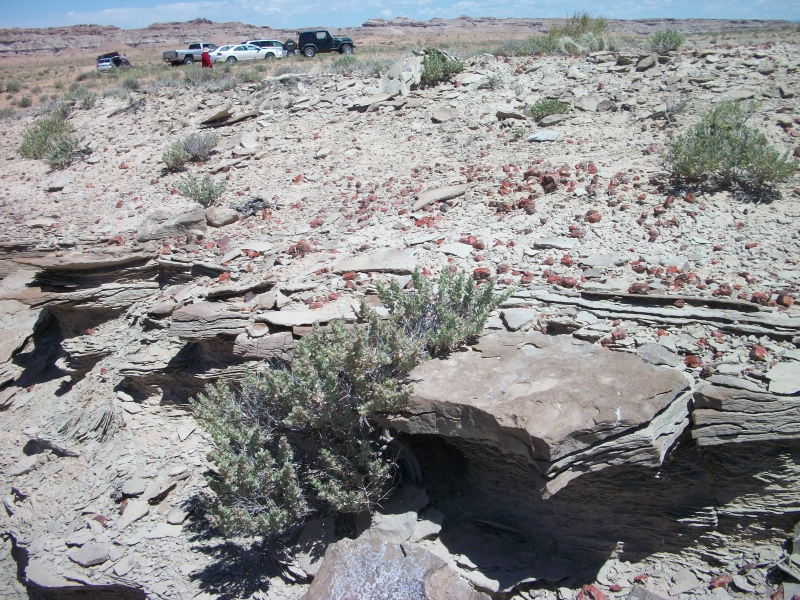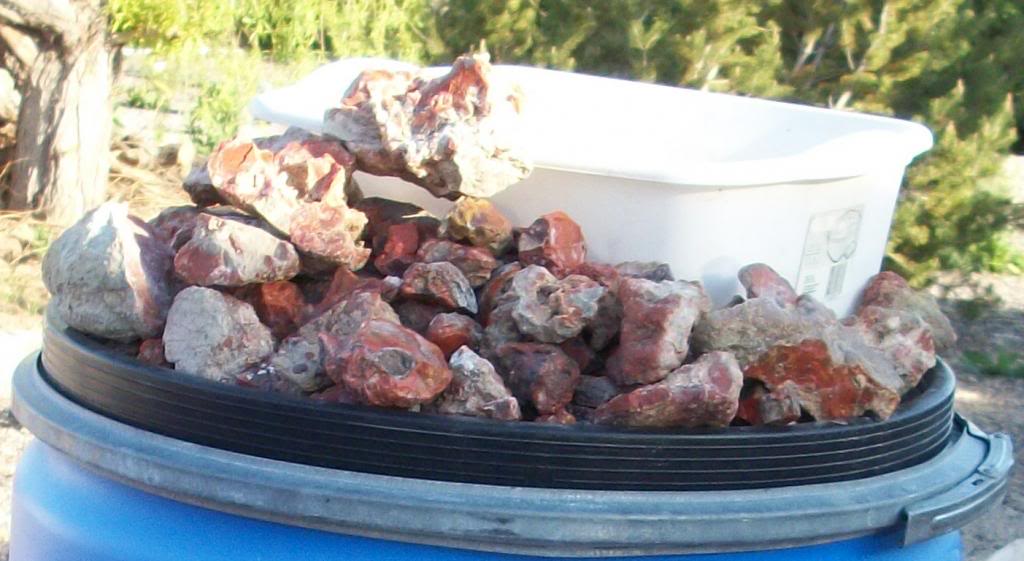The Agatized Stromatolites of the Horse Spring Formation
Nov 29, 2020 17:47:55 GMT -5
Fossilman, RWA3006, and 17 more like this
Post by NevadaBill on Nov 29, 2020 17:47:55 GMT -5
Good day!
I've been wanting to write this one up for a while now, and just got sidetracked with other stuff. So here goes...
Warning: I am by no means a geologist, expert, or should be considered anything other than a rock dummy. But I will do my best to report my findings.
Back story -
(optional read) - We are on the back side of Lake Mead at a Red Rock picnic area watching squirrels one afternoon in early 2018 (real exciting stuff!), and out of nowhere an Asian couple comes over and starts speaking another language to our group. Like, whuhh?? But then I look over and my Asian wife is talking back to them in the same kind of strange foreign tongue. It turns out to be Chinese. They don't know English.
(optional read) - The two Chinese aliens are in America, and here on vacation. And they are rockhounds (I am not familiar with the term), and have read about a mine or public claim that is nearby which they read about and they want to go there and pick up some shiny rocks and stuff. But they are lost, and can't find it. They only know the name of the turn off (dirt road), and have rough idea that it should be close by.
(optional read) - We offer to help even though I am not familiar with any mine, or shiny rocks, or the turn off. Taking a guess, we head West on the main road and I look out for signs in English. After a half dozen miles I spot the turn off. It is dirt, and soon turns in to un-improved dirt, and then somehow turns in to blacktop on top of dirt, and so we just guide them in to this area about a mile or two. It is all unknown.
(optional read) - But we stop in front of this clear sign marker. The marker states that we are on a claim owned by one of the local rock clubs (SNG&MS), and that it is called "Ore Car", and that there are several different types of gemstones which can be found about, and we are able to gather some for ourselves.

(optional read) - We all get out of our vehicles, chat shortly and then say our goodbye's to the couple, as they roam around looking for rocks and stuff. I don't see any shiny rocks (I don't know what I am looking at anyway). So we leave. But this stays in my mind somehow.
Here is a picture of the area that we will be walking today though:

That said, one of my very first interests in collecting rocks turns out to be this very location. It looks cool! So cool that I spend my rockhounding infancy roaming these hills and pick up all kinds of cool looking Leaverite and actually some shiny colored rocks too! The trails of the idiot geologist (as I call myself) begin!
By the way, after a couple of years I created a trip report for this destination. Here is the link in case anyone needs material to help them sleep better (Warning: Picture HEAVY link!):
Ok, back to the rocks. The entire Horse Spring Formation has been an ancient mud filled lake bed for a very long time. But much faulting occurred and long story short, the land was all upturned at a 45 degree angle all over the place (as can be seen in pictures above).
I have never really had much of an interest in Fossils, but for some reason I am drawn to the Stromatolites in this region.
This is a larger one which is not silicified much. There is nothing but clay layers. No Agate.

On one of my first visits, I was blocked from entering this location by flooding which wiped out the road in. I was standing outside and up walked a mostly naked man (just wearing some beat up shorts), out of the desert. He had been collecting Chert. I told him I was new, and saw some rocks that looked to me like Petrified Wood. He told me that there was little to no Pet Wood here, but what I had found was Fossilized micro organisms; Agatized Stromatolites. Whuhh?? Was that Chinese too?
It turns out that these little organisms are alive in large colonies, and build layer upon layer on top of each other as the water surrounds them and years pass. Here is a modern look at Stromatolites. I believe this is Australia.

So, while they looked like Pet Wood, they were in fact fossils. And the region which I was wandering through had all different varieties of maturity in silicification or Agatization of the little guys.
Check out this soft mud. In places you can find the Stromatolite, there are varying degrees of desert topology. Some can be found in dried up and layered mud like this:

In fact, here is a large and intact sample which I found only a few feet from the dried mud picture above:

It is kind of unusual to find whole examples. Partially due to weathering over the past 125 million years, and partially due to rock hounds who come up here with intent to smash every example they see, in the hopes of finding Agatized examples for their lapidary.
Here is another example which I took home. It is not Agatized, but has very broad layers which are very interesting and come in the size of a football:

This is not what the rockhounds are after though. But there is a huge variety in the age of the Stromatolites which can just be found in this region alone. Even walking a couple of hundred yards can reveal examples which are many millions of years more mature than others.
I am not going to go in to the actual geology of the fossils in any detail though, and am going to try to stick to mostly pictures here so that folks don't go completely to sleep (for anyone who is actually awake and still reading here, that is).
I have some favorite, whole, and Agatized examples of Stromatolites sitting on a small boulder in my yard. Beauty is in the eye of the beholder. And I am seriously impressed in the complexity, shapes and age of these unique specimens.

Some of my very first attempts at tumbling was with some smaller examples of these which I had found. This is when I discovered that no two are completely alike. The ones on the left are much more silicified (Agatized) than the ones on the right.

But in general, they do not tumble well due to their stratified nature, and the dissimilar hardness of those layers. In many cases the rocks undercut severely, and I realized that getting a finished tumble out of them was futile.
But in other cases I was more successful in tumbling them. The more Agatized (they are about a 7 on the Mohs scale) the example, the better it tumbled:

So I stopped tumbling them and put them aside for a while. Maybe some day I could learn of something to do with them.
After a great deal of exploration of the land formation (maybe after 6 months or so of walking the expansive property), I found some examples of Stromatolite which were much more ancient looking than many of the rest I had. To me these looked like petrified roots of plants or trees! I stuck them in my backpack, and at home I have a small amount of them sitting in a clay planter in a courtyard.

These broke apart naturally it appears. And to me it is really interesting to see all of the banding, twisting, and coloration of these ancient organisms which have fossilized over time! I am always looking at these or picking one up and hoping to see how i could creatively use them.
I purchased a rock saw a while back, and a grinder. In the past year I have pulled a couple of the smaller rocks out of the pile and put them on the grinder to see what I might get out of them. I found that if you tumble them, then they might undercut in cases. And in other cases if the silicification was satisfactory, then small cabochons could be made.
Here are some materials I worked on yesterday. Raw stone above, and finished cabs (free forms mostly) below:

The one in the middle is a 30x20, which I did my best with. It is difficult in some cases to stick to a template with all of these undulating shapes, and varying hardness of material.
Also in the example, the darker colors are more Agatized than the one on the far left. And the middle one is the softest of the group. But you can see what they were fashioned from. The raw material is very hard, and tricky to work with for me.
But I really love the banding on these little guys. I have put aside a few interesting examples next to the saw, so that I might see what the cuts could reveal.
As difficult to work with as these have been for me, I have managed to work a couple of them in to finished pendants.

The examples which became pendants were either tumbled in the vibratory tumbler with success after shaping with the grinder, or simply finished with Cerium Oxide on a wheel that was also mounted on the grinder.
At any rate I was happy to get something finished from the lot. I think that the finished product could have a chance at being something really nice. And they are even more interesting to me knowing some of the story of how these little guys were created.
So I am happy to finally be able to report on one of most early discoveries in my rockhounding journey.
I didn't think that I would be that interested in fossils that much, but some of the rocks pictured were of the first that I ever picked up. They have really captured my attention.
Thanks for stopping by to have a read!















